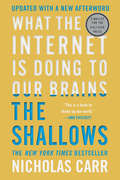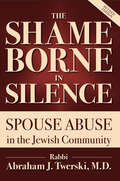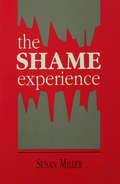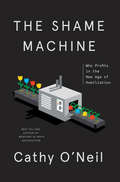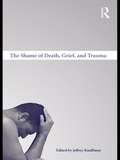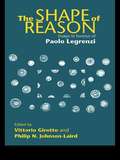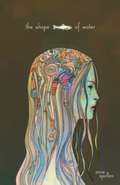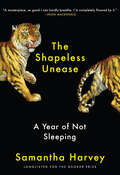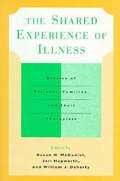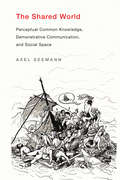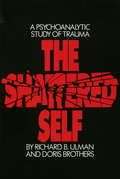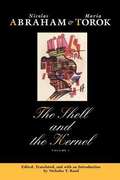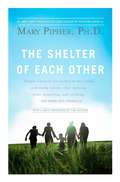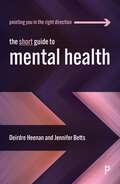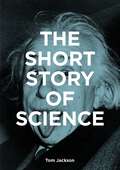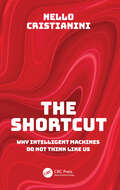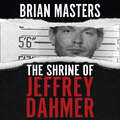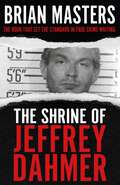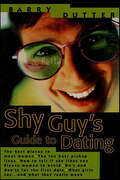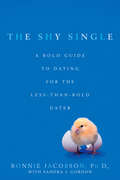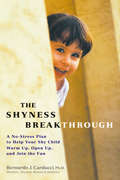- Table View
- List View
The Shallows: What The Internet Is Doing To Our Brains
by Nicholas CarrNew York Times bestseller • Finalist for the Pulitzer Prize “This is a book to shake up the world.” —Ann Patchett Nicholas Carr’s bestseller The Shallows has become a foundational book in one of the most important debates of our time: As we enjoy the internet’s bounties, are we sacrificing our ability to read and think deeply? This 10th-anniversary edition includes a new afterword that brings the story up to date, with a deep examination of the cognitive and behavioral effects of smartphones and social media.
The Shame Borne in Silence: Spouse Abuse in the Jewish Community
by Rabbi Abraham J. TwerskiProviding a religious lens on the topic, this book directly addresses the problem of spousal abuse in the Jewish community, in hopes of confronting the truth and taking definitive steps to end this violation of all that Judaism stands for. A leading rabbi and psychiatrist reveals with striking candor, firmness, and compassion what may have been closely kept dark secrets in many Jewish families and offers urgently needed advice and direction. Rabbi Twerski's book was one of the first titles to break open the issue, and this new edition relates the recognition of abuse, the warning signs, and how to respond.
The Shame Experience
by Susan MillerDrawing on a series of in-depth interviews illuminating the phenomenology of shame in the general public, Miller systematically explores the various dimensions of the shame experience. The complex relationships between shame and female sexual development, shame and phallic inhibition, and shame and orality are among the topics critically reexamined.
The Shame Machine: Who Profits in the New Age of Humiliation
by Cathy O'NeilA clear-eyed warning about the increasingly destructive influence of America&’s &“shame industrial complex&” in the age of social media and hyperpartisan politics—from the New York Times bestselling author of Weapons of Math Destruction&“O&’Neil reminds us that we must resist the urge to judge, belittle, and oversimplify, and instead allow always for complexity and lead always with empathy.&”—Dave Eggers, author of The EveryShame is a powerful and sometimes useful tool: When we publicly shame corrupt politicians, abusive celebrities, or predatory corporations, we reinforce values of fairness and justice. But as Cathy O&’Neil argues in this revelatory book, shaming has taken a new and dangerous turn. It is increasingly being weaponized—used as a way to shift responsibility for social problems from institutions to individuals. Shaming children for not being able to afford school lunches or adults for not being able to find work lets us off the hook as a society. After all, why pay higher taxes to fund programs for people who are fundamentally unworthy? O&’Neil explores the machinery behind all this shame, showing how governments, corporations, and the healthcare system capitalize on it. There are damning stories of rehab clinics, reentry programs, drug and diet companies, and social media platforms—all of which profit from &“punching down&” on the vulnerable. Woven throughout The Shame Machine is the story of O&’Neil&’s own struggle with body image and her recent weight-loss surgery, which awakened her to the systematic shaming of fat people seeking medical care.With clarity and nuance, O&’Neil dissects the relationship between shame and power. Whom does the system serve? Is it counter-productive to call out racists, misogynists, and vaccine skeptics? If so, when should someone be &“canceled&”? How do current incentive structures perpetuate the shaming cycle? And, most important, how can we all fight back?
The Shame of Death, Grief, and Trauma
by Jeffrey KauffmanShame is a common and pervasive feature of the human response to death and other losses, yet this often goes unrecognized due to a reluctance to acknowledge and confront it. This book intends to expose shame for what it is, allowing clinicians to see that it is the central psychological force in the understanding of death and mourning. Kauffman and his fellow authors explore the psychology of shame via observation, reflection, theory, and practice in order to demonstrate the significant role it can play in our processing of grief, death, and trauma. The authors avoid defining a unified theory of shame in order to emphasize its multitude of meanings and the impact this has on grief and grief therapy. First-person narratives provide a personal look at death and associated feelings of guilt, shock, and grief; and other chapters consider shame in the context of cultural differences, recent events, and contemporary art, literature, and film. This is the first book to offer a comprehensive examination of this topic and, as such, will be a valuable resource for all clinicians who work with clients affected by grief and loss.
The Shape of Reason: Essays in Honour of Paolo Legrenzi (Psychology Press Festschrift Series)
by Vittorio Girotto Philip N. Johnson-LairdOver the past three decades, there has been a rapid development of research on human thinking and reasoning. This volume provides a comprehensive review of this topic by looking at the important contributions Paolo Legrenzi has made to the field, by bridging the gap from Gestalt ideas to modern cognitive psychology. The contributors, including some of the most distinguished scholars of reasoning and thinking in Europe and the USA, reflect upon the ways in which he has influenced and inspired their own research, and contributed to modern approaches to human inference.This volume draws on both traditional and new topics in reasoning and thinking to provide a wide-ranging survey of human thought. It covers creativity, problem-solving, the linguistic and social aspects of reasoning and judgement, and the social and emotional aspects of decision making through telling examples, such as the cognitive mechanisms underlying consumers' attitudes towards herbal medicines. It considers a series of key questions, such as how do individuals who are unfamiliar with logic reason? And how do they make choices if they are unfamiliar with the probability calculus and decision theory?The discussions are placed throughout within a wider research context and the contributors consider the implications of their research for the field as a whole, making the volume an essential reference for anyone investigating the processes that underlies our thinking, reasoning, and decision-making in everyday life.
The Shape of Water
by Anne SpollenI had come to know silence well during those months after my mother died. When you sit in silence long enough, you learn that silence has a motion. It glides over you without shape or form, but with weight, exactly like water. Magda's mother always said the world was full of strange and beautiful secrets only the two of them could see. But now she's gone and Magda's world is flooded with anxiety and loneliness-- and maybe, madness. As an imaginary family of bickering fish begins to torment her, Magda's only outlet is starting beautiful but destructive fires in the marshes near her house. The Shape of Water is a darkly lyrical and surprising tapestry of the mundane and the surreal, in which Magda begins to untangle her family's secrets and search for a stable place in the world.
The Shapeless Unease: A Year of Not Sleeping
by Samantha Harvey&“Sleeplessness gets the Susan Sontag illness-as-metaphor treatment in this pensive, compact, lyrical inquiry into the author&’s nighttime demons.&” —Kirkus Reviews In 2016, Samantha Harvey began to lose sleep. She tried everything to appease her wakefulness: from medication to therapy, changes in her diet to changes in her living arrangements. Nothing seemed to help.The Shapeless Unease is Harvey&’s darkly funny and deeply intelligent anatomy of her insomnia, an immersive interior monologue of a year without one of the most basic human needs. Original and profound, and narrated with a lucid breathlessness, this is a startlingly insightful exploration of memory, writing and influence, death and the will to survive, from &“this generation&’s Virginia Woolf&” (Telegraph).&“Captures the essence of fractious emotions—anxiety, fear, grief, rage—in prose so elegant, so luminous, it practically shines from the page. Harvey is a hugely talented writer, and this is a book to relish.&” —Sarah Waters, New York Times–bestselling author&“Harvey writes with hypnotic power and poetic precision about—well, about everything: grief, pain, memory, family, the night sky, a lake at sunset, what it means to dream and what it means to suffer and survive . . . The big surprise is that this book about &‘shapeless unease&’ is, in the end, a glittering, playful and, yes, joyful celebration of that glorious gift of glorious life.&” —Daily Mail&“What a spectacularly good book. It is so controlled and yet so wild . . . easily one of the truest and best books I&’ve read about what it&’s like to be alive now, in this country.&” —Max Porter, award-winning author of Lanny
The Shaping of Modern Psychology: An Historical Introduction (Psychology Library Editions: History of Psychology)
by L.S. HearnshawOriginally published in 1987, The Shaping of Modern Psychology presents a systematic survey of the development of psychology from the dawn of civilization to the late 1980s. Psychology as we find it today has been shaped by many influences, philosophical, theological, scientific, medical and sociological. It has deep roots in the whole history of human thought, and its significance cannot be properly appreciated without an understanding of the way it has developed. This book covers the history of modern psychology from its animistic beginnings, through the Greek philosophers and the Christian theologians, and developments such as the Scientific Revolution, to the time of first publication. The author drew on many years’ teaching experience in the subject and on a lifetime’s interest in psychology. The growth of psychology had been particularly impressive during the twentieth century and Professor Hearnshaw also looked to the future of the discipline. He showed that the new vistas opening out in fields such as neuropsychology, information theory and artificial intelligence, for example, were hopeful indications for the future, provided the lessons of the past were not forgotten. With the benefit of hindsight, we now know that he was right!
The Shaping of Us: How Everyday Spaces Structure our Lives, Behaviour, and Well-Being
by Lily Bernheimer"You are going to be transported by what Bernheimer has to say. You'll make different decisions and figure out how your brain is working and what should be prioritized in your life" Jo Good, BBC LondonWhat makes everyday spaces work, how do they shape us, and what do they say about us?The spaces we live in - whether public areas, housing, offices, hospitals, or cities - mediate community, creativity, and our very identity, making us who we are. Using insights from environmental psychology, design, and architecture, The Shaping of Us reveals the often imperceptible ways in which our surroundings influence our behaviour.Wide-ranging and global examples cover the differences between personalities and nationalities, explore grass-roots and mainstream efforts to build environments promoting well-being, and look ahead to what will become of us if we don't listen closely to what we know is good for us.You will learn whether you are a natural 'prospector' or 'refuger' in the office environment, what roundabouts and stoplights say about British and American culture, whether you are guilty of NIMBYism or being drawn to 'ruin porn', and how the half-house may be a common sight in the near future.The environments we inhabit define our identities - from the earliest moments of our evolution to the worlds we build around ourselves.
The Shared Experience of Illness: Stories of Patients, Families, and Their Therapists
by Susan H. Mcdaniel Jeri Hepworth William J. DohertyIn the narrative of every human life and family, illness is a prominent character. Even if we have avoided serious illness ourselves, we cannot escape its reach into our circle of family and friends. Illness brings us closer to one another through caregiving and separates us through disability and death, yet little attention has been paid to personal and family illness in psychotherapy. Rather, therapists tend to focus on the psychosocial realm, leaving the biological realm to other physicians and nurses. This groundbreaking volume shows the powerful benefits that can emerge when therapists acknowledge illness as a vital part of everyone's psychology. Susan H. McDaniel, Jeri Hepworth, and William J. Doherty invited therapists who work with individuals and families experiencing chronic illness and disability to describe clinical cases that illustrate their approach to medical family therapy. Contributors then were asked to share a personal story about their experiences with illness, and to explain how those experiences affect the way they work with their clients. Vivid case studies dealing with a range of illnesses, including cancer infertility, schizophrenia, AIDS, heart disease, diabetes, asthma, and multiple sclerosis, show how the therapists' own experiences of illness are relevant to their care of others-and how these experiences can be used to form a healing bond in therapy. As we head toward a new century, therapists play a central role in the delivery of comprehensive healthcare. We now know that psychology and social factors have a direct effect on the development and exacerbation of illness and disease, and that involvement of the family with the healthcare team is vital. Poignant, honest, and illuminating, The Shared Experience of Illness allows us to understand more fully the relationship between the personal and the professional. This invaluable work provides inspiration and insight for anyone working at the cuttifng edge of our healthcare system.
The Shared World: Perceptual Common Knowledge, Demonstrative Communication, and Social Space (The\mit Press Ser.)
by Axel SeemannA novel treatment of the capacity for shared attention, joint action, and perceptual common knowledge.In The Shared World, Axel Seemann offers a new treatment of the capacity to perceive, act on, and know about the world together with others. Seemann argues that creatures capable of joint attention stand in a unique perceptual and epistemic relation to their surroundings; they operate in an environment that they, through their communication with their fellow perceivers, help constitute. Seemann shows that this relation can be marshaled to address a range of questions about the social aspect of the mind and its perceptual and cognitive capacities.Seemann begins with a conceptual question about a complex kind of sociocognitive phenomenon—perceptual common knowledge—and develops an empirically informed account of the spatial structure of the environment in and about which such knowledge is possible. In the course of his argument, he addresses such topics as demonstrative reference in communication, common knowledge about jointly perceived objects, and spatial awareness in joint perception and action.
The Shattered Self: A Psychoanalytic Study of Trauma
by Doris Brothers Richard B. UlmanUlman and Brothers utilize a unique clinical research population of rape and incest victims and Vietnam combat veterans to argue that trauma results from real occurrences that have, as their unconscious meaning, the shattering of "central organizing fantasies" of self in relation to selfobject. Their innovative treatment approach revolves around the transformation of these shattered fantasies in the intersubjective context of the transference-countertransference neurosis.
The Shell and the Kernel: Renewals of Psychoanalysis, Volume 1
by Nicolas Abraham Maria Torok Nicholas Rant Nicholas Rand<p>This volume is a superb introduction to the richness and originality of Abraham and Torok's approach to psychoanalysis and their psychoanalytic approach to literature. Abraham and Torok advocate a form of psychoanalysis that insists on the particularity of any individual's life story, the specificity of texts, and the singularity of historical situations. In what is both a critique and an extension of Freud, they develop interpretive strategies with powerful implications for clinicians, literary theorists, feminists, philosophers, and all others interested in the uses and limits of psychoanalysis. <p>Central to their approach is a general theory of psychic concealment, a poetics of hiding. Whether in a clinical setting or a literary text, they search out the unspeakable secret as a symptom of devastating trauma revealed only in linguistic or behavioral encodings. Their view of trauma provides the linchpin for new psychic and linguistic structures such as the "transgenerational phantom," an undisclosed family secret handed down to an unwitting descendant, and the intra-psychic secret or "crypt," which entombs an unspeakable but consummated desire. Throughout, Abraham and Torok seek to restore communication with those intimate recesses of the mind which are, for one reason or another, denied expression. <p>Classics of French theory and practice, the essays in volume one include four previously uncollected works by Maria Torok. Nicholas Rand supplies a substantial introductory essay and commentary throughout. Abraham and Torok's theories of fractured meaning and their search for coherence in the face of discontinuity and disruption have the potential to reshape not only psychoanalysis but all disciplines concerned with issues of textual, oral, or visual interpretation.</p>
The Shelter of Each Other
by Mary Pipher"Simple solutions for survival in this family-unfriendly culture...Eye-opening...heart-wrenching and uplifting."--San Francisco Chronicle Even more resonant today than at its original publication twelve years ago, The Shelter of Each Other traces the effects of our society's "anti-family" way of life, where parents are overtaxed, children are undersupervised, and technology is rapidly dictating how we interact. As she did in her number-one bestseller Reviving Ophelia, Mary Pipher illuminates how our families are suffering at the hands of shifting cultural norms, and she snaps our gave into crisp focus. Drawing on the fascinating stories of families rich and poor, angry and despairing, religious and skeptical, and probing deep into her own family memories and experiences, Pipher clears a path to the strength and energy at the core of family life. Compassionate and heart-wrenching, The Shelter of Each Other is an impassioned call for us to gather our families in our arms and hold on to them for dear life.
The Short Guide to Mental Health (Short Guides)
by Deirdre Heenan Jennifer BettsIn this clear and concise primer, Deirdre Heenan and Jennifer Betts lay out key concepts and debates in the field of mental health. With overviews of recent developments and stakeholder perspectives, the book introduces contemporary themes in policy and practice. It explores the prevalence, cost and social determinants of mental illness, the changing attitudes and stigma around them, and the roles of the state, voluntary and community sectors in designing and delivering services. Assuming no prior knowledge of the subject, the guide includes: • text boxes and figures to illustrate key points; • end of chapter summaries; • international case studies; • further reading guides. For students, practitioners, policy makers and newcomers alike, this is an accessible and comprehensive guide to an increasingly prioritised and debated topic.
The Short Story of Science: A Pocket Guide to Key Histories, Experiments, Theories, Instruments and Methods
by Tom Jackson Mark Fletcher'Nothing in life is to be feared. It is only to be understood. Now is the time to understand more, so that we may fear less' Marie CurieThe Short Story of Science is a new introduction to the complete subject of science. Covering 60 key experiments, from Archimedes' investigations of buoyancy to the discovery of dark matter, and then linking these to the history of science, as well as to the key theories and methods, the book simplifies and explains all the key breakthroughs.Accessible and concise, generously illustrated throughout, and with all the essential information presented without jargon, readers are given all the tools they need to enjoy the fascinating history of scientific knowledge.
The Short Story of Science: A Pocket Guide to Key Histories, Experiments, Theories, Instruments and Methods
by Tom Jackson Mark Fletcher'Nothing in life is to be feared. It is only to be understood. Now is the time to understand more, so that we may fear less' Marie CurieThe Short Story of Science is a new introduction to the complete subject of science. Covering 60 key experiments, from Archimedes' investigations of buoyancy to the discovery of dark matter, and then linking these to the history of science, as well as to the key theories and methods, the book simplifies and explains all the key breakthroughs.Accessible and concise, generously illustrated throughout, and with all the essential information presented without jargon, readers are given all the tools they need to enjoy the fascinating history of scientific knowledge.
The Shortcut: Why Intelligent Machines Do Not Think Like Us
by Nello CristianiniAn influential scientist in the field of artificial intelligence (AI) explains its fundamental concepts and how it is changing culture and society.A particular form of AI is now embedded in our tech, our infrastructure, and our lives. How did it get there? Where and why should we be concerned? And what should we do now? The Shortcut: Why Intelligent Machines Do Not Think Like Us provides an accessible yet probing exposure of AI in its prevalent form today, proposing a new narrative to connect and make sense of events that have happened in the recent tumultuous past, and enabling us to think soberly about the road ahead.This book is divided into ten carefully crafted and easily digestible chapters. Each chapter grapples with an important question for AI. Ranging from the scientific concepts that underpin the technology to wider implications for society, it develops a unified description using tools from different disciplines and avoiding unnecessary abstractions or words that end with -ism. The book uses real examples wherever possible, introducing the reader to the people who have created some of these technologies and to ideas shaping modern society that originate from the technical side of AI. It contains important practical advice about how we should approach AI in the future without promoting exaggerated hypes or fears.Entertaining and disturbing but always thoughtful, The Shortcut confronts the hidden logic of AI while preserving a space for human dignity. It is essential reading for anyone with an interest in AI, the history of technology, and the history of ideas. General readers will come away much more informed about how AI really works today and what we should do next.
The Shrine of Jeffrey Dahmer
by Brian MastersAn extraordinary analysis into the mind of a notorious killer which set the standard in true crime writing.________________________________________AN UNSPEAKABLE CRIME When he was arrested in July 1991, Jeffrey Dahmer had a severed head in the refrigerator, two more in the freezer, two skulls and a skeleton in a filing cabinet.A DEPRIVED ACTBut if anything could be more disturbing than the brute horror of this scene, it was the evidence that Dahmer had been using these human remains not only for sexual gratification, but as part of a dark ritual of his own devising -- to furnish a shrine to himself.A KILLER, BEYOND OUR UNDERSTANDING________________________________________The Shrine of Jeffrey Dahmer offers a chilling insight into the mind of a serial killer and reveals the horrors within. Perfect for fans of Making a Murderer, Mindhunter and The Ted Bundy Tapes, this is a gripping and gruesome read that delves into the mind of a murder and what possesses someone to kill. (P) 2020 Hodder & Stoughton Ltd
The Shrine of Jeffrey Dahmer
by Brian Masters________________________________________AN UNSPEAKABLE CRIME When he was arrested in July 1991, Jeffrey Dahmer had a severed head in the refrigerator, two more in the freezer, two skulls and a skeleton in a filing cabinet.A DEPRIVED ACTBut if anything could be more disturbing than the brute horror of this scene, it was the evidence that Dahmer had been using these human remains not only for sexual gratification, but as part of a dark ritual of his own devising -- to furnish a shrine to himself.A KILLER, BEYOND OUR UNDERSTANDING________________________________________The Shrine of Jeffrey Dahmer offers a chilling insight into the mind of a serial killer and reveals the horrors within. Perfect for fans of Making a Murderer, Mindhunter and The Ted Bundy Tapes, this is a gripping and gruesome read that delves into the mind of a murder and what possesses someone to kill. __________By the author of Killing for Company, which was adapted into the hit ITV true crime drama DES, starring David Tennant. __________PRAISE FOR THE SHRINE OF JEFFREY DAHMER:'Irresistible. . . . It's subject is terrible and repellent. But the study itself is enlightening' Independent 'Unputdownable' Patricia Highsmith 'The persuasive account of a young man spiraling into unspeakable insanity . . . fascinating' Daily Telegraph
The Shrine of Jeffrey Dahmer
by Brian Masters________________________________________AN UNSPEAKABLE CRIME When he was arrested in July 1991, Jeffrey Dahmer had a severed head in the refrigerator, two more in the freezer, two skulls and a skeleton in a filing cabinet.A DEPRIVED ACTBut if anything could be more disturbing than the brute horror of this scene, it was the evidence that Dahmer had been using these human remains not only for sexual gratification, but as part of a dark ritual of his own devising -- to furnish a shrine to himself.A KILLER, BEYOND OUR UNDERSTANDING________________________________________The Shrine of Jeffrey Dahmer offers a chilling insight into the mind of a serial killer and reveals the horrors within. Perfect for fans of Making a Murderer, Mindhunter and The Ted Bundy Tapes, this is a gripping and gruesome read that delves into the mind of a murder and what possesses someone to kill. __________By the author of Killing for Company, which was adapted into the hit ITV true crime drama DES, starring David Tennant. __________PRAISE FOR THE SHRINE OF JEFFREY DAHMER:'Irresistible. . . . It's subject is terrible and repellent. But the study itself is enlightening' Independent 'Unputdownable' Patricia Highsmith 'The persuasive account of a young man spiraling into unspeakable insanity . . . fascinating' Daily Telegraph
The Shy Guy's Guide to Dating
by Barry DutterThe authoritative guide that will take shy guys everywhere-from the first date to home plate."Hey baby, what's your sign?" "Come here often?"These lines may work in the movies, but not in real life, and not for the millions of guys too shy to risk their dignity on such flimsy pickup lines. Barry Dutter knows, he used to be a shy guy himself, sitting at home night after night watching television because asking a woman for a date was simply too scary.Not anymore. He's learned dozens of tricks to help shy guys ease into the swing of dating while avoiding humiliating rejections and romantic disasters. Keeping a shy guy's tender ego in mind, he tells guys where to meet women, which ones to approach and which to avoid. Readers will learn what to do with them, and how to act from the first date through commitment time. Filled with hilarious lessons from the pop culture we grew up in, this witty, commonsense guide is a must for everyone who's ever been afraid to try-which means everyone.
The Shy Single: A Bold Guide to Dating for the Less-than-Bold Dater
by Bonnie Jacobson Sandra J. GordonNearly 50 percent of adults in the United States describe themselves as chronically shy, and an even larger number are single. These numbers prove what we already know: There are a lot of us sitting home alone, letting the dating world pass us by. But it doesn't have to be that way! In The Shy Single, New York psychologist Bonnie Jacobson outlines her breakthrough program that helps shy men and women securely maneuver any social situation. At the heart of the book is her confidence-boosting plan for managing the three stages of a shyness attack. A dating profile quiz, journaling exercises, cumulative courage-rating scores, and real testimonies from Dr. Jacobson's extraordinarily popular shyness workshops round out the "coach's corner" advice for shy daters on how to: - Work a room and get past awkward introductions - Participate in dinner conversations and bridge uncomfortable silences - Ask someone out - End a date gracefully - Handle sexual advances The aim of The Shy Single is not to make us un-shy, but to enable us to function despite our pounding hearts and sweaty palms. With small, manageable steps, we can gain self-assurance and learn how to finesse awkward or possibly embarrassing situations. Navigate a room with small talk? No problem. Ask out a coworker? No sweat. Make the first move in an intimate situation? You bet. From going online to declining a second date to determining whether we've found "the one," Dr. Jacobson shows us that dating happiness isn't just for other, more outgoing people--it's for us.
The Shyness Breakthrough: A No-Stress Plan to Help Your Shy Child Warm Up, Open Up, and Join tthe Fun
by Bernardo CarducciIs your child being held back by shyness?Dr. Bernardo Carducci, one of the world's leading authorities on shy behavior, shows you how to help your child join the fun by plainly explaining: • The causes of childhood shyness (it's not genetic) • Why children don't just "grow out of it"--and why it's crucial to address shyness early in life • The family dynamics that may secretly be triggering shy behavior • Why shyness can drive teenagers to rebellious or cynical behavior Understand your child's unique shyness profile and discover how to create a personalized Shyness Breakthrough Plan to ease him through: • The first day at a new school • Meeting relatives • Being called on in class • Slumber parties • Sports practices, music lessons, visiting Santa, and more!
